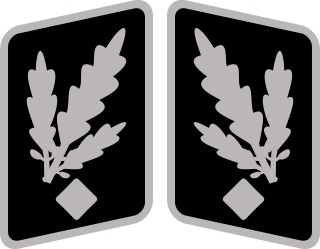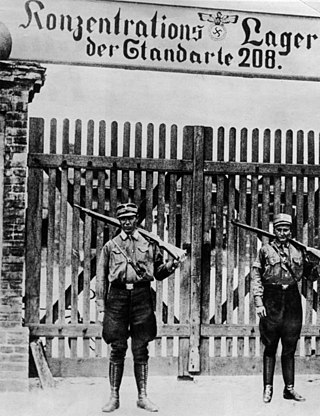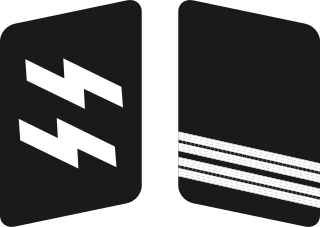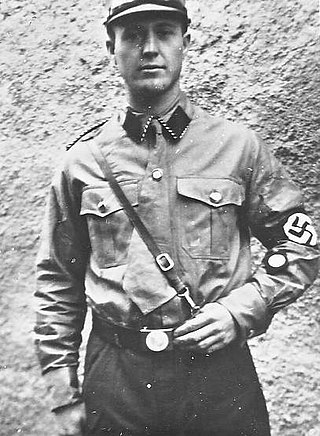
Gruppenführer was an early paramilitary rank of the Nazi Party (NSDAP), first created in 1925 as a senior rank of the SA. Since then, the term Gruppenführer is also used for leaders of groups/teams of the police, fire departments, military and several other organizations.

Obergruppenführer was a paramilitary rank in Nazi Germany that was first created in 1932 as a rank of the Sturmabteilung (SA) and adopted by the Schutzstaffel (SS) one year later. Until April 1942, it was the highest commissioned SS rank after only Reichsführer-SS. Translated as "senior group leader", the rank of Obergruppenführer was senior to Gruppenführer. A similarly named rank of Untergruppenführer existed in the SA from 1929 to 1930 and as a title until 1933. In April 1942, the new rank of SS-Oberst-Gruppenführer was created which was above Obergruppenführer and below Reichsführer-SS.

Oberführer was an early paramilitary rank of the Nazi Party (NSDAP) dating back to 1921. An Oberführer was typically an NSDAP member in charge of a group of paramilitary units in a particular geographical region. From 1921 to 1925, the phrase Oberführer was used as a title in the Sturmabteilung (SA), but became an actual SA rank after 1926.

The uniforms and insignia of the Sturmabteilung (SA) were Nazi Party paramilitary ranks and uniforms used by SA stormtroopers from 1921 until the fall of Nazi Germany in 1945. The titles and phrases used by the SA were the basis for paramilitary titles used by several other Nazi paramilitary groups, among them the Schutzstaffel (SS). Early SS ranks were identical to the SA, since the SS was originally considered a sub-organisation of the Sturmabteilung.

Scharführer was a title or rank used in early 20th century German military terminology. In German, Schar was one term for the smallest sub-unit, equivalent to a "troop", "squad", or "section". The word führer simply meant "leader".

Obersturmführer was a Nazi Germany paramilitary rank that was used in several Nazi organisations, such as the SA, SS, NSKK and the NSFK.

Sturmmann was a Nazi Party paramilitary rank that was first created in the year 1921. The rank of Sturmmann was used by the Sturmabteilung (SA) and the Schutzstaffel (SS).

Rottenführer was a Nazi Party paramilitary rank that was first created in the year 1932. The rank of Rottenführer was used by several Nazi paramilitary groups, among them the Sturmabteilung (SA), the Schutzstaffel (SS) and was senior to the paramilitary rank of Sturmmann.

Oberscharführer was a Nazi Party paramilitary rank that existed between 1932 and 1945. Oberscharführer was first used as a rank of the Sturmabteilung (SA) and was created due to an expansion of the enlisted positions required by growing SA membership in the late 1920s and early 1930s. The SA rank of Oberscharführer was senior to Scharführer and junior to the rank of Truppführer.
National Socialist paramilitary ranks were pseudo-military titles, which were used by the Nazi Party, between 1920 and 1945. Since the Nazi Party was by its very nature a paramilitary organisation, by the time of World War II, several systems of paramilitary ranks had come into existence for both the Nazi Party itself and various Nazi paramilitary organisations.

The National Socialist Flyers Corps was a paramilitary aviation organization of the Nazi Party.

The National Socialist Motor Corps was a paramilitary organization of the Nazi Party (NSDAP) that officially existed from May 1931 to 1945. The group was a successor organisation to the older National Socialist Automobile Corps, which had existed since April 1930.

The ranks and insignia of the National Socialist Motor Corps were a paramilitary rank system in Germany used between the years of 1931 and 1945. They were based closely on the ranks and insignia of the Sturmabteilung (SA), of which the NSKK was originally a part.

Adolf Hühnlein was a German soldier and Nazi Party (NSDAP) official. He was the Korpsführer of the National Socialist Motor Corps (NSKK) from 1933 until his death in 1942.

The government of Nazi Germany was a totalitarian dictatorship governed by Adolf Hitler and the Nazi Party according to the Führerprinzip. Nazi Germany was established in January 1933 with the appointment of Adolf Hitler as Chancellor of Germany, followed by suspension of basic rights with the Reichstag Fire Decree and the Enabling Act which gave Hitler's regime the power to pass and enforce laws without the involvement of the Reichstag or German president, and de facto ended with Germany's surrender in World War II on 8 May 1945 and de jure ended with the Berlin Declaration on 5 June 1945.
Hermann Höfle was a German SS and police official during the Nazi era who served as SS and Police Leader (HSSPF).

Ich Kämpfe was a book given by the Nazi Party to each new enrollee from 1942 until 1944. Nearly all copies of this book were destroyed at the end of the war under the Allied policy of denazification, with the result that originals are very rare.
In Nazi Germany, the Standarte was a paramilitary unit of Nazi Party (NSDAP), Sturmabteilung (SA), NSKK, NSFK, and Schutzstaffel (SS). Translated literally as "Regimental standard", the name refers to the flag paramilitary formations carried in formations and parades.
Transportkorps Speer was created in 1944 from Legion Speer and the units of the National Socialist Motor Corps that was serving the Organisation Todt. Shortly after its creation it became subordinated to the Wehrmacht. Yet, its major mission remained in support of OT, which at this time was mainly engaged in rebuilding and repair of bomb damaged industrial facilities and housing complexes. Transportkorps Speer was organized in motor transportation battalions and regiments, supported by depot, repair, engineering, signal, and medical units.



















